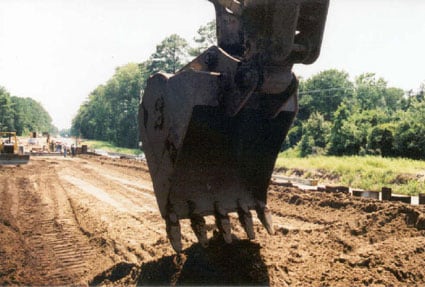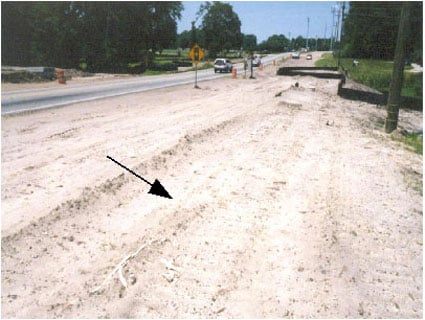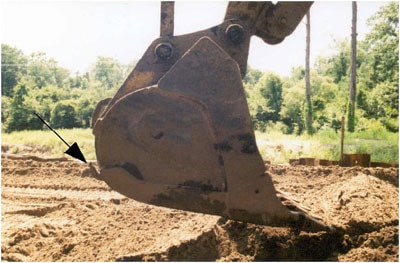Hispanic Pipe Layer Dies After Being Struck by Excavator (Track Hoe) Bucket on Construction Site - South Carolina
NIOSH In-house FACE Report 2003-12
January 23, 2004
Summary
On May 29, 2003, a 23-year-old male Hispanic pipe layer (the victim) died after being struck by the bucket teeth of an excavator (track hoe). The victim, and a crew of four other workers were installing concrete drain pipe alongside a public roadway. The excavator operator was reportedly in the process of extending the trench for the accommodation of another 8-foot section of the pipe. When making the cut, the bucket teeth (Photo 1) struck the victim at the right-side chest and neck area, causing nearly immediate fatal injuries. Emergency medical service (EMS) and the local fire department were notified and responded within minutes. The victim was pronounced dead at the scene.
NIOSH investigators concluded that to help prevent similar occurrences, employers should
- instruct excavator equipment operators to ensure that the area is clear of workers before moving the machine
- ensure that safety instructions included in the manufacturer’s operator’s manual are followed
- ensure that a signal person or spotter is used when moving, swinging, or operating the excavating machinery in trenching operations
- develop, implement and enforce a comprehensive safety training program in language(s) and literacy level(s) that all workers understand that includes, but is not limited to, hazard recognition training, avoidance of unsafe work conditions and safe trenching procedures
Introduction
On May 29, 2003, a 23-year-old male Hispanic pipe layer (the victim) died after being struck by the bucket teeth of an excavator (track hoe). On June 2, 2003, the South Carolina Department of Labor, Licensing and Regulation, Office of Occupational Safety and Health (SCOSH) notified the National Institute for Occupational Safety and Health (NIOSH), Division of Safety Research (DSR) of the incident. On June 18, 2003, the Team Leader for the Trauma Investigations Section (TIS), Fatality Assessment and Control Evaluation (FACE) program met with the SCOSH investigator and reviewed the incident. On June 24, 2003, the TIS Chief and an Associate Service Fellow traveled to South Carolina to investigate the incident. The investigators met with the local police department, the county coroner, and the safety director and employees of the company involved in the incident. The investigators also visited a local excavator equipment manufacturer’s sales facility to review the excavator operator’s manual. The police report, police photos, and the coroner’s report were reviewed. The investigators visited the site of this incident where photographs of the site and excavator were taken.
The employer, a general contractor specializing in roadway work, has been in business for approximately 30 years. This company is owned by the general contractor as a trenching and excavation subsidiary. This subsidiary has been conducting business for about 8 years, and had 95 employees at the time of the incident. All of the employees on this five-man crew, except the excavator operator, were Hispanic. None of the Hispanic employees were able to speak, read, or understand English. The company has a safety manual written in English that includes a section/chapter related to trenching. None of the employees received formal safety and health training from this company, or specific training on the safety and health manual – all training was provided on-the-job. The company has employed an English-speaking full-time safety director on its staff since March of 2003. This was the victim’s first job since arriving in the United States, where he had worked full-time since January, 2003.
Regular safety meetings were not being held at the time of the incident, however, the company has since instituted regular safety training sessions with all personnel, both on-site and in classroom settings. The employer is also planning to use tool-box safety materials printed in Spanish. This was the company’s first workplace fatality.
Back to Top
Investigation
The employer had been contracted by the state of South Carolina to install concrete water drainage piping along the public roadway (Photo 2). On May 29, 2003, the five-man crew began work at approximately 8:00 a.m. The crew did not begin trench work until approximately 1:00 p.m., due to rain. The crew consisted of an excavator operator, a pipe layer (the victim), a laborer (rigger), a foreman, and a “hill-man” (spotter for the excavator and part-time surveyor whose responsibilities included operating laser-leveling equipment to ensure that pipe was installed on grade). The excavator was equipped with a three-foot wide bucket, having five teeth that measured approximately 3″ wide at the point, and 11″ in length from the bucket. (Photo 1)
The function of the crew and crew members had reportedly remained the same since the job began in January. The assignment for the remainder of the day was to continue to lay 8-foot sections of 24- inch inner diameter (i.d.) concrete drain pipe. The crew was reportedly assigned the goal of laying a certain number of pipe sections, and reaching a certain point of progression prior to quitting for the day. Since January, this crew had been successful in laying over 2,000 feet of pipe.
The process for laying the pipe on this site began by the excavator operator cutting a trench into the soil (the trench at the site of the incident reportedly measured approximately 5 feet 6 inches deep and 8 feet 11 inches wide at the ground surface level). The trench depths were noted to have typically ranged from approximately 6 to 11 feet throughout the job. A trench box was not used on this site; however, the walls of the trench were reportedly sloped and/or benched back.
During the process of laying the drain pipe, the pipe layer (the victim) would stand on the existing section of pipe and make the pipe connection as a new section was lowered into the trench. The operator would then back-fill the trench with soil to within two or three feet from the end of the pipe. The pipe layer (the victim) would stand on the exposed area of the pipe and wait for the next section of pipe. After back-filling, the operator would put the excavator in reverse gear and back up to make an additional cut in the trench to accommodate a new section of pipe. After making the cut, the operator would raise the boom/stick and bucket and swing the superstructure of the excavator around approximately 160 degrees away and behind the existing trench. The operator would then lower the boom/stick and bucket to a point where the rigger could prepare the rigging equipment in a choker configuration around a new section of pipe for hoisting. The rigger would then ensure that the rigging was attached to the hook of the excavator bucket (Photo 3). Once rigged with the new section of pipe, the operator would lift the pipe section, swing the excavator back toward the trench, and lower the pipe into place. The pipe layer (the victim) would then step off of the pipe and make the connection between the existing section and the newly laid section. He would then place a laser “target” into the pipe to make sure that the pipe was aligned and on-grade with the laser equipment. The operator would back-fill the trench again to within two or three feet from the end, and the entire process would be repeated.
At the time of the incident, the spotter for the excavator was in a man-hole box near the laser surveying equipment approximately 80 feet away from the victim and excavator. (Note: The spotter was reportedly “mudding” the box and was not available to spot for the operator, and the foreman was across the road performing other duties). After the pipe was connected and aligned, the operator back filled the trench within two to three feet from the end. Just as this was completed, the victim apparently stepped-up on the pipe just as the operator was reversing the excavator to make the next cut into the soil. The victim was apparently between the bucket and the superstructure of the excavator and was struck during the process. The operator immediately raised the boom and swung it away from the victim, and then lowered the bucket to the bottom of the trench. He then yelled to co-workers for help. EMS was summoned and arrived within minutes. The victim was pronounced dead on site.
Back to Top
Cause of Death
The coroner indicated that the cause of death was due to blunt trauma to the right neck and chest region.
Recommendations/Discussion
Recommendation #1: Employers should instruct excavator operators to ensure that the area is clear of workers, and that workers are in a safe place before moving the machine.
Discussion: Operators should be instructed and trained by employers to ensure that all workers and other persons are outside of the working area of the boom/stick and bucket prior to moving the machine. It is critical that the operator know the specific location of all workers and bystanders before moving, swinging, or operating the machine. On this site, the pipe layer typically remained in the trench working around the moving excavator bucket while the operator positioned the pipe, re-positioned the excavator, and made new cuts into the soil. The trench was 10 to 11 feet in length after back-filling, and as the excavator operator lowered the 8 foot pipe into the trench the open space was reduced to approximately 2 to 3 feet. The bucket of the excavator was approximately 4 feet deep – which did not allow for a significant amount of room for the operator to move the excavator. Whenever possible, workers and pipe layers should exit the immediate area to a safe place before the operator moves the equipment. Had the pipe layer been instructed and trained to move out of the trench during the phase(s) of work where the excavator was moving and digging, this incident may have been prevented.
Recommendation #2: Employers should ensure that safety instructions included in the manufacturer’s operator’s manual are followed.1
Discussion: According to the manufacturer’s operating manual, the operator is to “Use Horn or other signal to warn bystanders before moving machine.” In this incident, the operator was not aware of the victim’s location and the victim apparently was not aware that the operator was moving the machine. The employer did not have any operating policies or procedures that included using a horn or other signal that could have warned the victim that the operator was moving the machine.
Recommendation #3: Employers should ensure that a signal person or spotter is used when moving, swinging, or operating excavation machinery in trenching operations.
Discussion: The process used in laying pipe on this site was relatively congested due to the confines of the trench dimensions. The employer had a “spotter” on this site, but he had been re-assigned to mud the manhole box approximately 80 feet away from the victim.
Recommendation #4: Employers should develop, implement and enforce a comprehensive safety training program in language(s) and literacy level(s) that all workers understand that includes, but is not limited to, hazard recognition training, avoidance of unsafe work conditions and safe trenching procedures.
Discussion: Although this employer reportedly had a safety manual with a section specific to trenching, the manual was written in English. The employer reportedly used an interpreter for conveying tasks, but the safety director stated that it was unclear whether the interpreter was using a dialect and literacy level that the employees could understand, or exactly what the interpreter was telling them. A method to ensure comprehension of information could be to provide instructions in a dialect that they can comprehend, and provide verbal and/or written testing to ensure that the information conveyed was understood.
Back to Top
References
- Excavator Manufacturer’s Operator’s Manual.
Investigator Information
This incident was investigated by Robert E. Koedam, Chief, Trauma Investigations Section, and Timothy Struttmann, Associate Service Fellow, Surveillance and Field Investigations Branch, Division of Safety Research, NIOSH.
Back to Top
Photographs

|
|
Photo 1. Excavator bucket and bucket teeth.
|
|
Photo 2. Incident job site and approximate location of incident (arrow).
|
|
Photo 3. The arrow points to the hook on the bucket used to attach the rigging.
|


